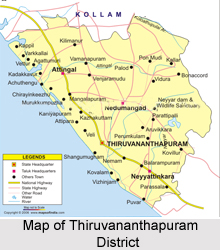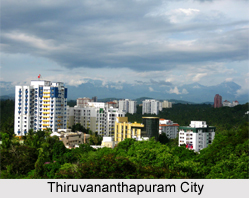 Thiruvananthapuram district is the southern-most district in the state of Kerala. The name Thiruvananthapuram is derived from the term `Thiru Anantha Puram`, or the city of the Holy Anantha. It has been named after Ananthan, the cosmic serpent with a thousand heads, on whose coils Lord Mahavishnu reclines. Thiruvananthapuram, built on seven hills, has today grown Hills into a sprawling metropolis; but the city still retains her past glory and charm. The Mahatma Gandhi Road, the chief artery of the city, is lined by traditional mansions that proclaim the grandeur of the times past and modern high-rises that testify to the city`s newfound affluence and a brashly commercial taste --red tile and timber vying with concrete and glass. A number of beautiful places of tourism are located here, and the district revels in the celebration of a number of fairs and festivals.
Thiruvananthapuram district is the southern-most district in the state of Kerala. The name Thiruvananthapuram is derived from the term `Thiru Anantha Puram`, or the city of the Holy Anantha. It has been named after Ananthan, the cosmic serpent with a thousand heads, on whose coils Lord Mahavishnu reclines. Thiruvananthapuram, built on seven hills, has today grown Hills into a sprawling metropolis; but the city still retains her past glory and charm. The Mahatma Gandhi Road, the chief artery of the city, is lined by traditional mansions that proclaim the grandeur of the times past and modern high-rises that testify to the city`s newfound affluence and a brashly commercial taste --red tile and timber vying with concrete and glass. A number of beautiful places of tourism are located here, and the district revels in the celebration of a number of fairs and festivals.
Location of Thiruvananthapuram District
Thiruvananthapuram district is located in the state of Kerala. It is situated between 8 degrees 17 minutes and 8 degrees 54 north latitudes and east longitudes of 76 degrees 41 minutes and 77 degrees 17 minutes. The southernmost point of the district, Parasala, is 56 Kms away from Kanyakumari. The district stretches along the shores of the Arabian Sea for a distance of 78 Kms. It is bounded on the east by the Tirunelvelli district of Tamil Nadu, on the South by the Kanyakumari district, on the West by the Arabian Sea and on the North by the Kollam district. The total area covered by the district is 2192 Sq. Kms.
History of Thiruvananthapuram District
Thiruvananthapuram district had an important role to play in the political and cultural history of South Kerala. The Ays held fort here for a long period of time till the beginning of the 10th century when the rulers of Venad came into prominence. English presence came here for the first time in 1684, when the British East India Company acquired land at Anjengo, 32 Kms north of Thiruvananthapuram city, with a view to establishing a factory here. From here they extended their rule over different parts of Travancore. Modern history commenced with Marthanda Varma, was held as the father of Modern Travancore.
From here they extended their rule over different parts of Travancore. Modern history commenced with Marthanda Varma, was held as the father of Modern Travancore.
Thiruvananthapuram has been held as a great centre of intellectual and artistic activities during this point in time. The reign of Maharaja Swathi Thirunal brought about great economic and cultural prosperity of the region.
Geography of Thiruvananthapuram District
Thiruvananthapuram district is divided into three geographical regions. These are the highlands, midlands and lowlands. The highland regions are made up mainly of mountains. This area is bounded on the east and northeast by the Western Ghats mountain range. It is ideal for major cash crop plantations, such as tea, rubber, cardamom and other spices.
Timber trees are also grown in the region. The midland region lies between the Western Ghats and the lowlands. It is an area of intense agricultural activity made up of small hills and valleys. Cashew, tapioca, paddy and spices are grown here in abundance. By comparison, the lowlands are narrow and made up of rivers, delta and seashore. The region is covered with coconut palms. The Ghats maintain an average elevation of 814 meters rising to peaks of 1219 to 1829 meters in certain places. The climate of the district is greatly affected by the large forest reserves, bringing about more rain in the districts. The humidity is quite high and rises to about 90 percent during the southwest monsoon. The average rainfall is around 150 cms per annum. The district gets rainfall from both the southwest and northeast monsoons. The coolest months of the year are December, January and February. April and May are the hot months. The district has a rich collection of flora and fauna. Plants found here range from medicinal plants, rare orchids, spices, hedge plants, tuber crops and plants yielding edible fruits and fibre yielding plants. The forests of the district abound in a variety of animals and birds and its adjacent areas are conducive to the growth of wild life.  Elephants, bison, monkeys and rare species of reptiles have the place of distinction in them. There are three main rivers in the district- the Neyyar, Karamana and the Vamanapuram River. There are ten major backwaters in the district.
Elephants, bison, monkeys and rare species of reptiles have the place of distinction in them. There are three main rivers in the district- the Neyyar, Karamana and the Vamanapuram River. There are ten major backwaters in the district.
People of Thiruvananthapuram District
The major language spoken by the people in the district is the Malayalam language. The city of Thiruvananthapuram is more cosmopolitan, and a variety of languages are spoken here- English, Hindi, Malayalam, Tamil and Tulu language. The majority of the population is made up of Hindus, followed by Christians and Muslims. Hindus are divided into groups on the basis of caste. . The Nairs, the Nadars, the Ezhavas, the scheduled castes and 11 tribes form the majority of the Hindu community. A large part of the population is also made up of Muslims. Christians belong primarily to the Church of South India, the Latin Catholic Church and the Orthodox Syrian Church.
Economy of Thiruvananthapuram District
Agriculture is the main source of income in the district. More than 50 percent of the population depends on agriculture as a means of living. Of the total labour class, almost 42 percent is made up by the agricultural labourers. A majority of the people in the district are engaged in low remunerative pursuits which require very little capital. Economic developments have gone a long way in moulding the attitude and outlook of the people. Oil mills, cashew factories, cotton textiles, saw mills, printing units, rubber industrial units, chemical units, match factories, general engineering units and automobile workshops are the major industrial units here. The S.M.S.M. Institute in Thiruvananthapuram is a major institution through which the products of the handicraft industries are marketed.
 Tourism in Thiruvananthapuram District
Tourism in Thiruvananthapuram District
Tourism is one of the major contributors to the economy of the district. Tourism in the district of Thiruvananthapuram is like a trip through all the beauty that the state of Kerala has to offer. Beautiful hill stations, the famous backwaters of Kerala, beaches, wildlife sanctuaries and lagoons are present in the district. Medical tourism is a major attraction in the district due to the prevalence of Ayurveda here. The various places of tourist interest here include the Ponmuddi resort; the Neyyar Dam; Agastyakoodam, the highest peak in the western ghats(after Anamudi) where Sage Agastya is said to have had his abode; the beautiful Kovalam beach; Napier Museum, Veli Lagoon and many more beautiful places.






